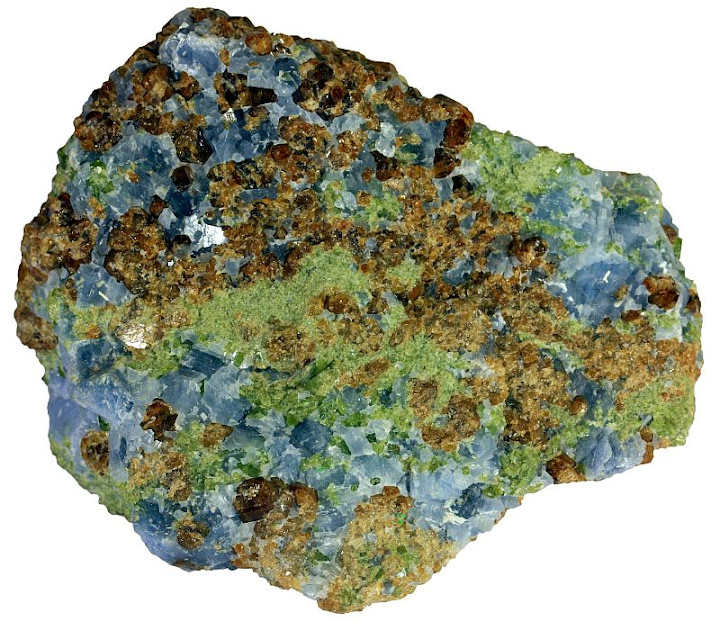Geologists have to know lots of terms to understand each other. It is especially true if we want to understand our predecessors notes because terminology tends to change as time goes by.
Today I want to demonstrate a really interesting rock that is probably composed of calcite, hessonite, and fassaite. Calcite is familiar to everyone but what were the other ones? I knew hessonite or essonite before but I had to check what fassaite means. Hessonite is a brownish variety of grossular (one of garnet group minerals, I’ve written about almandine and pyrope before) and fassaite is a light-colored greenish variety of augite (monoclinic pyroxene).

The rock sample is composed of calcite (blue), garnet (brown grossular), and pyroxene (green augite). Mount Monzoni, Northern Italy. Width of hand sample 6 cm.
The original description says it is: “fassaite, hessonite”. I try to broaden this laconic identification hint. The blue mineral is most likely calcite because it reacts vigorously with dilute hydrochloric acid. The mineral assemblage strongly suggests that this rock sample is a calc-silicate rock. These are metamorphic rocks that contain lots of calcium-bearing silicate minerals. There are several possible ways how such rocks may form.
Perhaps it was originally impure limestone bed (that’s why we have so much calcite) that got buried deep enough for the metamorphic reactions to begin. Or maybe the limestone bed was intruded by silicate fluids from a nearby igneous intrusion. Calcite reacts easily with these fluids and the result is the formation of somewhat unusual Ca-bearing minerals like grossular, andradite, diopside, wollastonite, tremolite, etc. The rocks with such mineralogy are called skarns or tactites. They often contain economically important ore minerals as well. The most common garnet in skarn is andradite, less commonly grossular. Skarns are very interesting rocks and useful as well but their identification is somewhat complicated. There is really no easily recognizable appearance. It is a mineral assemblage (lots of Ca-bearing silicates ± ore minerals ± carbonates) that should get your attention.
In particular case it seems to me that there was magmatic intrusion involved. By the way, this locality (Mt Monzoni) gave name to the rock type “monzonite” which is an igneous rock. I am thinking that perhaps this rock formed in the contact aureole around magma intrusion (possibly monzonitic in composition although I know that in an ironic way rocks that give a name to a rock type are in the end often found to be something else) which was surrounded by carbonate rocks. This part of the Alps is composed of carbonate rocks. Even their name, The Dolomites, refers to that.
That’s a lovely rock. The juxtaposition of colors (and mineralogies) is great. I have a sample of some lovely grossular/epidote/sulfide skarn rock from the Albion Basin in Utah here in the states, but nothing comes close to that powder-blue calcite.
Matt, I’d love to see that sample. Skarns are very cool rocks but unfortunately little known.